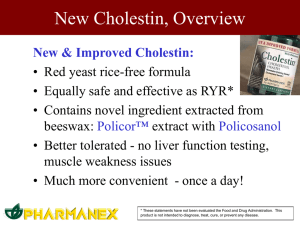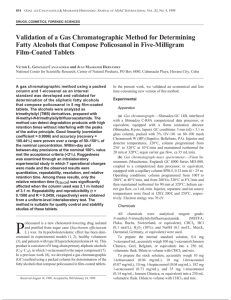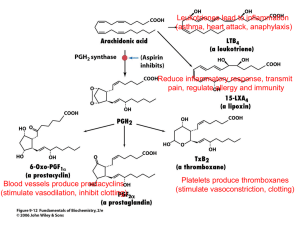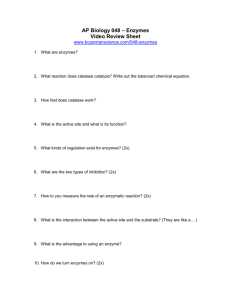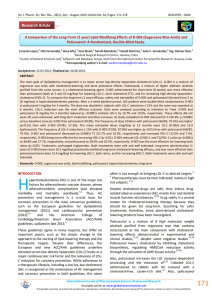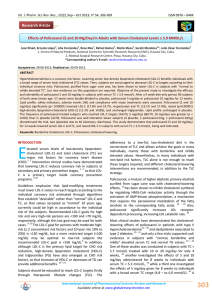Document 13309023
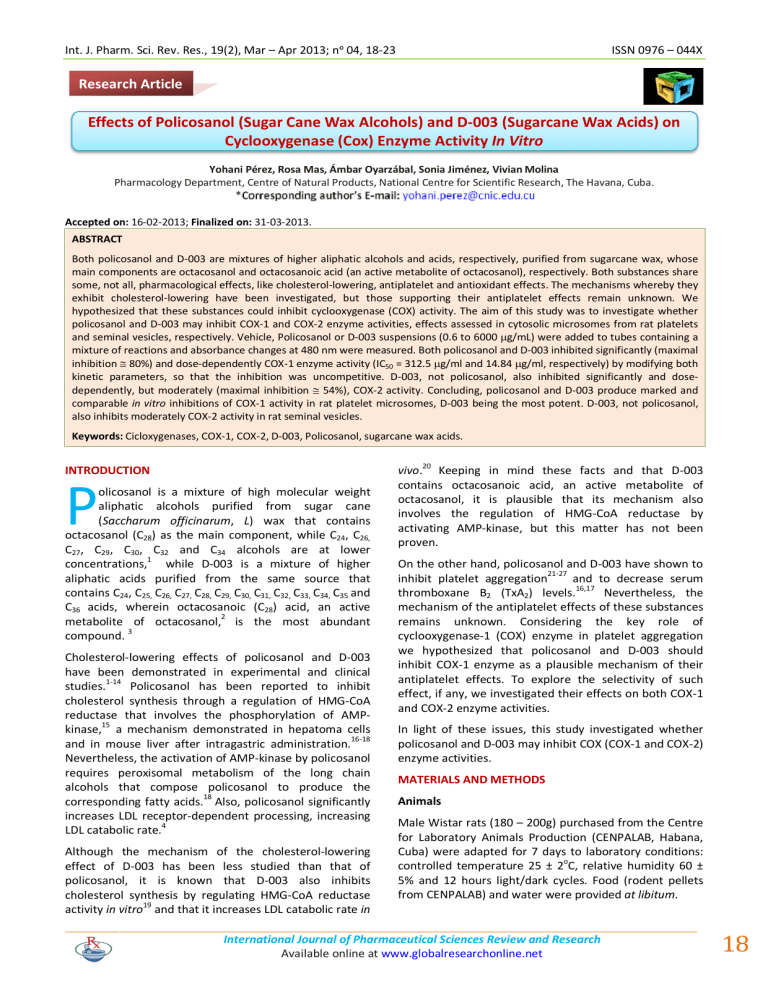
Int. J. Pharm. Sci. Rev. Res., 19(2), Mar – Apr 2013; n ᵒ 04, 18-23 ISSN 0976 – 044X
Research Article
Effects of Policosanol (Sugar Cane Wax Alcohols) and D-003 (Sugarcane Wax Acids) on
Cyclooxygenase (Cox) Enzyme Activity In Vitro
Yohani Pérez, Rosa Mas, Ámbar Oyarzábal, Sonia Jiménez, Vivian Molina
Pharmacology Department, Centre of Natural Products, National Centre for Scientific Research, The Havana, Cuba.
Accepted on: 16-02-2013; Finalized on: 31-03-2013.
ABSTRACT
Both policosanol and D-003 are mixtures of higher aliphatic alcohols and acids, respectively, purified from sugarcane wax, whose main components are octacosanol and octacosanoic acid (an active metabolite of octacosanol), respectively. Both substances share some, not all, pharmacological effects, like cholesterol-lowering, antiplatelet and antioxidant effects. The mechanisms whereby they exhibit cholesterol-lowering have been investigated, but those supporting their antiplatelet effects remain unknown. We hypothesized that these substances could inhibit cyclooxygenase (COX) activity. The aim of this study was to investigate whether policosanol and D-003 may inhibit COX-1 and COX-2 enzyme activities, effects assessed in cytosolic microsomes from rat platelets and seminal vesicles, respectively. Vehicle, Policosanol or D-003 suspensions (0.6 to 6000 g/mL) were added to tubes containing a mixture of reactions and absorbance changes at 480 nm were measured. Both policosanol and D-003 inhibited significantly (maximal inhibition 80%) and dose-dependently COX-1 enzyme activity (IC
50
= 312.5 g/ml and 14.84 g/ml, respectively) by modifying both kinetic parameters, so that the inhibition was uncompetitive. D-003, not policosanol, also inhibited significantly and dosedependently, but moderately (maximal inhibition 54%), COX-2 activity. Concluding, policosanol and D-003 produce marked and comparable in vitro inhibitions of COX-1 activity in rat platelet microsomes, D-003 being the most potent. D-003, not policosanol, also inhibits moderately COX-2 activity in rat seminal vesicles.
Keywords: Cicloxygenases, COX-1, COX-2, D-003, Policosanol, sugarcane wax acids.
INTRODUCTION
P olicosanol is a mixture of high molecular weight aliphatic alcohols purified from sugar cane
(Saccharum officinarum, L) wax that contains octacosanol (C
28
) as the main component, while C
24
, C
26,
C
27
, C
29
, C
30
, C
32
and C
34
alcohols are at lower concentrations,
1
while D-003 is a mixture of higher aliphatic acids purified from the same source that contains C
24
, C
25,
C
26,
C
27,
C
28,
C
29,
C
30,
C
31,
C
32,
C
33,
C
34,
C
35 and
C
36 acids, wherein octacosanoic (C metabolite of octacosanol,
2 compound.
3
28
) acid, an active is the most abundant
Cholesterol-lowering effects of policosanol and D-003 have been demonstrated in experimental and clinical studies.
1-14
Policosanol has been reported to inhibit cholesterol synthesis through a regulation of HMG-CoA reductase that involves the phosphorylation of AMPkinase,
15
a mechanism demonstrated in hepatoma cells and in mouse liver after intragastric administration.
16-18
Nevertheless, the activation of AMP-kinase by policosanol requires peroxisomal metabolism of the long chain alcohols that compose policosanol to produce the corresponding fatty acids.
18
Also, policosanol significantly increases LDL receptor-dependent processing, increasing
LDL catabolic rate.
4
vivo.
20
Keeping in mind these facts and that D-003 contains octacosanoic acid, an active metabolite of octacosanol, it is plausible that its mechanism also involves the regulation of HMG-CoA reductase by activating AMP-kinase, but this matter has not been proven.
On the other hand, policosanol and D-003 have shown to inhibit platelet aggregation thromboxane B
2
(TxA
2
21-27
) levels.
and to decrease serum
16,17
Nevertheless, the mechanism of the antiplatelet effects of these substances remains unknown. Considering the key role of cyclooxygenase-1 (COX) enzyme in platelet aggregation we hypothesized that policosanol and D-003 should inhibit COX-1 enzyme as a plausible mechanism of their antiplatelet effects. To explore the selectivity of such effect, if any, we investigated their effects on both COX-1 and COX-2 enzyme activities.
In light of these issues, this study investigated whether policosanol and D-003 may inhibit COX (COX-1 and COX-2) enzyme activities.
MATERIALS AND METHODS
Animals
Although the mechanism of the cholesterol-lowering effect of D-003 has been less studied than that of policosanol, it is known that D-003 also inhibits cholesterol synthesis by regulating HMG-CoA reductase activity in vitro
19
and that it increases LDL catabolic rate in
Male Wistar rats (180 – 200g) purchased from the Centre for Laboratory Animals Production (CENPALAB, Habana,
Cuba) were adapted for 7 days to laboratory conditions: controlled temperature 25 ± 2 o
C, relative humidity 60 ±
5% and 12 hours light/dark cycles. Food (rodent pellets from CENPALAB) and water were provided at libitum.
18 International Journal of Pharmaceutical Sciences Review and Research
Available online at www.globalresearchonline.net
Int. J. Pharm. Sci. Rev. Res., 19(2), Mar – Apr 2013; n ᵒ 04, 18-23 ISSN 0976 – 044X
After a 12 hour fast rats were anaesthetized in ether atmosphere, sacrificed by exsanguinations. Effects on
COX-1 and COX-2 activities were assessed in cytosolic microsomal preparations from rat platelets and rat seminal vesicles, respectively.
The study was conducted in accordance with the Cuban
Guidelines for the laboratory animals care and Good
Laboratory Practices. An independent ethic board for animal use approved the protocol of this study.
Materials
All chemicals were purchased from Sigma-Aldrich Co. (St
Louis, MO), except 2,2 azo-bis-2-amidinopropane hydrochloride (ABAP), obtained from Polyscience
(Warington, PA). Ultracentrifuge was from Beckman
(Beckman Instruments, Inc. Palo Alto, CA) and Utrospec-
Plus spectrophotometer from LKB (Pharmacia LKB
Biotechnology, Uppsala, Sweden).
Administration and dosage
Policosanol was obtained from the Plant of Natural
Products (National Centre for Scientific Research, The
Havana, Cuba), after corroborate that they met the quality criteria for batch releases. The composition of the policosanol batch, assessed with a validated gas chromatographic method
28
was as follows: tetracosanol
0.07%, hexacosanol 4.9%, heptacosanol 0.8%, octacosanol 63.8%, nonacosanol 0.5%, triacontanol
12.8%, dotriacontanol 6.8%, tetratriacontanol 2.4%. In turn, D-003 contained tetracosanoic 0.4%, pentacosanoic
0.3%, hexacosanoic 1.0%, heptacosanoic 3.1%, octacosanoic 57.0%, nonacosanoic 3.0%, triacontanoic
20.0%, hentriacontanoic 1.2%, dotriacontanoic 12.1%, tritriacontanoic 2.0%, tetratriacontanoic 12.0%, pentatriacontanoic 0.5%, hexatriacontanoic 6.1%. This composition was determined by using a specific gas chromatographic method for this substance.
29
Policosanol and D-003 were given as suspensions prepared in Tween 20/water (2%) vehicle. Indomethacin
(Cuban Pharmaceutical Industry –QUIMEFA-) was dissolved in 5% sodium bicarbonate.
Preparation of the rat platelets microsomal fraction
The effects on COX-1 activity were assessed by using enzyme microsomal preparations from rat platelets. In brief, venous blood samples were collected in tubes containing sodium citrate (38%) 9:1 (v/v). The tubes were centrifuged at 160 x g for 10 min at 10 o
C and the supernatant was centrifuged again at 2100 x g for 10 min at 10 o
C. The pellet was re-suspended in Tris-HCl EDTA
(50 mol/L, pH 7.4, 1 mol/L EDTA) and ammonium oxalate
(2%) 1/20 (v/v) and centrifuged at 2100 x g for 10 min at
4 o
C. The pellet was re-suspended again the same Tris-HCl
EDTA buffer, sonicated (3 cycles of 30 sec, sub-maximal potency) and centrifuged at 15000 x g for 20 min at 4 o
C.
Finally, the supernatant was centrifuged at 100 000 x g for
2 hours at 4 o
C. The pellet (platelets microsomal fraction) was re-suspended in 0.05 mol/L Tris/HCl buffer (pH 8.4)
International Journal of Pharmaceutical Sciences Review and Research
Available online at www.globalresearchonline.net containing 0.01% Triton X-100) 1:9 (p/v) and frozen at-
20 o
C until use.
30
Preparation of the rat seminal vesicles microsomal fraction
The effects on COX-2 activity were assessed by using microsomal preparations from rat seminal vesicles. In brief, seminal vesicle slices were homogenized in 0.05 mol/L Tris/HCl buffer (pH 8.4) containing 0.01% Triton X-
100) 1:9 (p/v) with a potter. The homogenates were centrifuged at 15000 x g for 15 min and the supernatant was centrifuged again at 100000 x g for 1 hour, all operations being carried out at 4
(microsomal fraction) was frozen at-20 o o
C, the pellet
C until use.
31
Effects on COX enzyme activity
COX activity was measured in accordance to Abad et al.,
1994.
31
The reaction mixture contained 2 mmol/L arachidonic acid (AA); microsomal fraction (1 mg/ml); 5.8 mmol/L L-epinephrine and 0.05 mol/L Tris HCl) buffer(pH
8.4). Tubes containing the vehicle, policosanol or D-003
(0.6, 4.8, 19.5, 78.1, 312.5, 1250, 2500, 5000, 5500, 6000
g/ml), or indomethacin (0.4 g/ml) (reference inhibitor) were run in parallel. Then, mixture reactions were preincubated with L-epinephrine for 4 min first and then AA was added at 37 o
C. The changes of optical density (O.D.) at 480 nm were measured for 10 min in the spectrophotometer. The enzyme activity was expressed as the changes of O.D./mg of protein.
Each experiment was run in triplicate and the results averaged. The concentration producing a 50% inhibition
(IC
50
) was calculated from the outline of the inhibition percentages as a function of the concentrations of the intended inhibitors (policosanol or D-003). The effects on
COX reaction rates were assessed in front of increasing concentrations of the substrate (AA 7.8, 31.2, 62.5, 125, and 250 mmol/L).
Once the substrate was added, we measured the increase of D.O. at 234 nm per min for 10 min in the spectrophotometer. The enzyme activity was expressed as mol of conjugated dienes/min/mg protein. The initial reaction rate was determined from the slope of the straight line portion of the curve and the percentage inhibition of the enzyme activity was calculated by comparing with the control samples.
Statistical analyses
Data were expressed as the mean ±SD. Comparisons between treated and control groups were performed with the Kruskal-Wallis and the Mann-Whitney U tests.
Statistical significance was chosen for α= 0.05. Dose effect relationships were assessed by using a linear regression and correlation test. Regression analysis was used to calculate IC
50
, defined as the concentration of inhibitor necessary for 50% inhibition of the enzyme reaction. Data were processed with the Statistics
Software for Windows (Release 4.2 Stat Soft Inc, Tulsa OK,
US).
19
Int. J. Pharm. Sci. Rev. Res., 19(2), Mar – Apr 2013; n ᵒ 04, 18-23 ISSN 0976 – 044X
RESULTS
Table 1 summarizes the effects on COX-1 activity. The addition of policosanol (0.6 - 6000 g/ml), inhibited COX-
1 activity (r= 0.993; p< 0.05) (IC
50
= 312.5 g/ml) significantly and dose-dependently. A maximal inhibition of about 80% was achieved with 5500 µg/mL. In turn, D-
003 addition (0.6 - 6000 g/ml) also produced a significant and dose-dependent inhibition of COX-1
(r=0.971; p< 0.05) (IC
50
= 14.84 g/ml) (maximal inhibition, reached with 1250 µg/mL, was approximately
80%).
Table 1: Effects of policosanol and D-003 on COX-1 enzyme activity on rat platelets microsomal fraction
Concentrations
(µg/ml)
Enzyme activity
( OD/min/mg protein)
Inhibition (%)
31.2, 62.5, 125 and 250 mmol/L). Policosanol modified the values of both kinetic parameters Km (-1/Km, intercept with abscise axis) and Vmax (1/Vmax, intercept with the ordinate axis) of COX-1 enzyme activity.
Figure 1: Lineweaver-Burk plot (1/v0 versus1/[S]0), of the effect of policosanol (62.5 µg/ml) on the initial rate of the enzyme reaction measured in front of increasing concentrations of the substrate (arachidonic acid 7.8,
5000
5500
6000
D-003
0.6
1.2
4.8
Control (0)
Policosanol
0.6
1.2
4.8
19.5
78.1
312.5
1250
19.5
78.1
312.5
1250
5000
5500
6000
Indomethacine
0.350 ± 0.001
0.316 ± 0.003
0.275 ± 0.001
0.258 ± 0.001
0.212 ± 0.005*
0.188 ± 0.002*
0.147 ± 0.001**
0.138 ± 0.005**
0.089 ± 0.004**
0.077 ± 0.001**
0.077 ± 0.001**
0.279 ± 0.006
0.240 ± 0.034*
0.192 ± 0.067*
0.169 ± 0.036*
0.137 ± 0.052*
0.086 ± 0.048*
0.077 ± 0.002**
0.076 ± 0.004**
0.069 ± 0.001**
0.071 ± 0.001**
-
20
32
45
52
61
75
78
78
80
80
10
21
26
39
46
58
61
75
78
78
Figure 2: Lineweaver-Burk plot (1/v
0
versus1/[S]
0
), of the effect of D003 (62.5 µg/ml) on the initial rate of the enzyme reaction measured in front of increasing concentrations of the substrate (arachidonic acid 7.8,
31.2, 62.5, 125 and 250 mmol/L). D-003 modified the values of both kinetic parameters Km (-1/Km, intercept with abscise axis) and Vmax (1/Vmax, intercept with the ordinate axis) of COX-1 enzyme activity.
0.059 ± 0.003*** 83
Comparison with the control (Mann Whitney U test)
The inhibitory effects of policosanol and D-003 involved the modification of both kinetic parameters (Vmax and
Km) of COX-1 activity (Figures 1 and 2, Lineweaver-Burk plots), therefore, the inhibition was uncompetitive.
By contrast, D-003 inhibited significantly and dosedependently (r=0.990; p< 0.05), although moderately
(maximal inhibition 54%) COX-2 enzyme activity. This inhibition involved the modification of Vmax and Km
(Lineweaver-Burk plot, data not shown for simplicity), so that it was uncompetitive. Indomethacin (0.4 g/ml) inhibited COX-1 and Cox-2 inhibited enzyme activities by
83 and 89%, respectively.
Table 2 summarizes the effects on COX-2 activity.
Although policosanol produced a moderated and dosedependently reduction of COX-2 activity (r= 0.972; p<
0.05), the comparisons with the control were not significant and the inhibition (39%) achieved with the highest dose (6000 µg/ml) was below the criterion to be considered as an effective enzyme inhibitor.
International Journal of Pharmaceutical Sciences Review and Research
Available online at www.globalresearchonline.net
20
Int. J. Pharm. Sci. Rev. Res., 19(2), Mar – Apr 2013; n ᵒ 04, 18-23 ISSN 0976 – 044X
Table 2: Effects of policosanol and D-003 on COX-2 enzyme activity on rat vesicle seminal microsomal fraction
Concentrations
(µg/ml)
D-003
6000
0.6
1.2
4.8
19.5
78.1
312.5
1250
5000
5500
6000
Control (0)
Policosanol
0.6
1.2
4.8
19.5
78.1
312.5
1250
5000
5500
Enzyme activity
( OD/min/mg protein)
0.350 ± 0.001
0.341 ± 0.007
0.307 ± 0.003
0.288 ± 0.002
0.275 ± 0.005
0.249 ± 0.001
0.231 ± 0.001
0.224 ± 0.001
0.216 ± 0.001
0.216 ± 0.001
0.214 ± 0.001
0.320 ± 0.015
0.290 ± 0.014
0.265 ± 0.039
0.248 ± 0.038
0.238 ± 0.005
0.225 ± 0.005
0.193 ± 0.030
0.163 ± 0.053*
0.163 ± 0.055*
0.161 ± 0.051*
Inhibition (%)
-
3
12
18
21
29
34
36
38
38
39
9
17
24
29
32
36
45
53
54
54 concentration of D-003 (1250 g/ml) is about 4.4 times lower than that of policosanol (5500 g/ml).
The inhibitory effects of policosanol and D-003 on COX-1 activity were uncompetitive since they modified the affinity for the substrate (Km) and the Vmax of the enzymatic reaction, which suggests that instead of interacting with the enzyme active site, they should interact with a site near to that in such a way that may curtail the enzyme reaction. The present study does not support more details of such interaction, which should be further investigated. Nevertheless, considering the long structures of high molecular weight alcohols and acids, their direct interaction with the enzyme active site should not be probable.
The remarkable effects of policosanol and D-003 on COX-
1 as compared to COX-2 are consistent with their antiplatelet effects, as COX-1 enzyme isoform is the key enzyme for the formation of eicosanoids in platelets, where this enzyme is expressed.
The effect of D-003 on COX-1 activity, however, was not specific because it also produced a significant and dosedependent inhibition of COX-2 activity, although modest in magnitude (54% inhibition). This finding suggests that
D-003 should act as a non selective NSAID that share antiplatelet and antiinflammatory effects, as other drugs of this class, but such hypothesis deserves the in vivo demonstration of the antiinflammatory action of D-003, a matter not explored yet.
32
In line with these results, significant reductions of serum TxB
2
(an inactive metabolite of thromboxane A
2
) levels have been observed with policosanol and D-003.
24-26
Indomethacine 0.040 ± 0.001*** 89
0.4
(Mean ± SD) O.D. Optical density; *p<0.05, **p<0.01, ***p<0.001,
Comparison with the control (Mann Whitney U test)
DISCUSSION
On its side, policosanol produced a dose-dependent reduction of COX-2 activity up to 39% that suggests some inhibitory action on this target, but it failed to inhibit this enzyme activity significantly, so that we do not expect a clinically relevant antiinflammatory effect derived from its effect on COX-2.
This study demonstrates that the addition of policosanol and D-003 (0.6 - 6000 g/ml) produce comparable in vitro inhibitions of COX-1 activity in rat platelet microsomes, D-
003 being more potent than policosanol. D-003, not policosanol, also inhibits COX-2 activity in rat seminal vesicles, but moderately.
As expected, the addition of indomethacin 0.4 µmol/L, a non selective NSAID used as a reference inhibitor, inhibited both COX-1 and COX-2 by 83 and 89%, respectively. This result confers validity to our experimental conditions to test COX-1 and COX-2 enzyme activities and to the present results.
The inhibitions of COX-1 enzyme activity with policosanol and D-003 were marked, so that maximal inhibitions of about 80% were obtained with the two substances.
Despite the fact that the inhibitory effects of both treatments were similar, D-003 was more potent than policosanol, as reflects their IC
50
values (14.84 g/ml and
312.5 g/ml, respectively). This affirmation is also supported by the fact that the maximal inhibitory
The recent demonstration of the in vivo antiinflammatory effects of octacosanol, the main component of policosanol,
33
and of other mixtures of long chain alcohols,
34,35 suggests that policosanol should exhibit this effect. In such case, not demonstrated yet, such antiinflammatory effect, if any, should be ascribed mainly to the inhibition of COX-1 rather than to its mild and not significant effect on COX-2. Nevertheless, since this study investigated the effects on COX activities in vitro, not in
vivo, we cannot exclude that policosanol may produce a meaningful inhibition of COX-2 in vivo as result from the metabolic transformation of the long chain fatty alcohols into fatty acids, as occurs in the case of cholesterol synthesis.
18
The present results merit, therefore, to explore the antiinflammatory effect of policosanol in vivo, and if any, its probable mechanism beyond COX-1 inhibition.
International Journal of Pharmaceutical Sciences Review and Research
Available online at www.globalresearchonline.net
21
Int. J. Pharm. Sci. Rev. Res., 19(2), Mar – Apr 2013; n ᵒ 04, 18-23 ISSN 0976 – 044X
CONCLUSION
Policosanol and D-003 produce marked and comparable
in vitro inhibitions of COX-1 activity in rat platelet microsomes, D-003 being more potent than policosanol.
D-003, not policosanol, also inhibits COX-2 activity in rat seminal vesicles, but moderately. This study gives, for the first time, some clues of the antiplatelet mechanism of policosanol and D-003.
REFERENCES
13.
Castaño G, Mas R, Fernández L, Illnait J, Fernández JC,
Mendoza S, A comparison of the effects of D-003 and policosanol (5 and 10 mg/d) in patients with Type II hypercholesterolemia: a randomized, double-blinded study, Drugs Experimental Clinical Research, 31, 2005, 31-
44.
14.
Arruzazabala ML, López E, Molina V, Illnait J, Carbajal D,
Fernández JC, Mas R, Efectos del D-003, mezcla de ácidos grados de la caña de azúcar, sobre el perfil lipídico y la agregación plaquetaria de pacientes con diabetes tipo 2.
Un ensayo controlado con placebo, Acta Bioquímica Clínica
Latinoamericana, 44, 2010, 15-24. 1.
Mas R, Policosanol, Drugs of the Future, 25, 2000, 569-86.
2.
Menéndez R, Marrero D, Mas R, González RM, In vitro and
in vivo study of octacosanol metabolism, Archive Medical
Research, 36, 2005, 113-119.
3.
Mas R, D-003: A new substance with promising lipid modifying and pleiotropic effects for atherosclerosis management, Drugs of the Future, 29, 2004, 773-786.
4.
Menéndez R, Arruzazabala ML, Más R, González RM, Amor
AM, Jiménez S, Cholesterol-lowering effect of policosanol on rabbits with hypercholesterolemia induced by a wheat starch-casein diet, British Journal Nutraceutical, 77, 1997,
923-932.
15.
Menéndez R, Amor A, Rodeiro I, González RM, Jiménez S,
Mas R, Policosanol modulates HMGCoA reductase activity in cultured fibroblasts, Archive Medicine Research, 32,
2001, 8-12 (a).
16.
Singh DK, Porter TD, Policosanol inhibits cholesterol synthesis in hepatoma cells by activation of AMP-kinase,
Journal Pharmacology Therapeutic, 2006, 318, 1020-1025.
17.
Oliaro S, Calcio E, Mantegna S, Regualtion of HMGCoA reductase by policosanol and octacosadienol, a new synthetic analogue of octacosanol, Lipids, 10, 2009, 33-38.
5.
Setnikar I, Senin P, Rovati LC, Antiatherosclerotic efficacy of policosanol, red yeast rice extract and astaxanthin in the rabbit, Arzneimittel forschung, 2005, 55, 312-317.
6.
Menéndez R, Mas R, Amor AM, Más R, González RM,
Jimenez S, Effects of policosanol treatment on the susceptibility of low density lipoprotein (LDL) isolated from healthy volunteers to oxidative modification in vitro, British
Journal Clinical Pharmacology, 50, 2000, 255-262.
18.
Banerjee S, Ghoshal S, Porter TD, Activation of AMP-kinase by policosanol requires peroxisomal metabolism, Lipids
2011, 27, 24-30.
19.
Menéndez R, Mas R, Amor AM, Rodeiro I, González RM,
Jiménez S, Mas R, Inhibition of cholesterol biosynthesis in cultured fibroblasts by D-003, a mixture of very long chain saturated fatty acids, Pharmacology Research, 44, 2001,
299-304 (b).
7.
Mas R, Castaño G, Illnait J, Fernández L, Fernández JC,
Alemán C, Rodeiro I, Effects of policosanol in patients with type II hypercholesterolemia and additional coronary risk factors, Clinical Pharmacology Therapeutic, 65, 1999, 439-
447.
20.
Menéndez R, Mas R, Pérez J, González RM, Jiménez S, Oral administration of D-003, a mixture of very long chain saturated fatty acids, prevents casein-induced endogenous hypercholesterolemia in rabbits, Canadian Journal
Physiology Pharmacology, 82, 2004, 22-29.
8.
Nikitin IP, Slepchenko NV, Gratsianskii NA, Results of the multicenter controlled study of the hypolipidemic policosanol in Russia, Terapevtichesky Arkhiv, 72, 2000, 7-
10.
9.
Wang Y, Kuanman KE, Wang H L, Jiao Y, Zhao X, Sun N, Yang
X, Sun R, Efficacy and safety of policosanol and pravastatin in treatment of hyperlipidemia in Chinese patients, Journal
New Drugs Clinical Research, 2008, 2, 124-29.
21.
Arruzazabala ML, Carbajal D, Mas R, García M, Fraga V,
Effects of policosanol on platelet aggregation in rats,
Thromboxano Research, 69, 1993, 321-327.
22.
Scazziota A, Pons S, Altman R, Efecto del policosanol sobre la función de las plaquetas en voluntarios sanos. Revista
Iberoamericana Trombo Hemostasia, 9, 1996, 58-62.
10.
Gámez R, Mendoza S, Más R, Mesa R, Castaño G, Rodríguez
B, García A, Dose-dependent cholesterol-lowering effects of D-003 on normocholesterolemic rabbits, Current
Therapeutic Research Clinical & Experimental, 61, 2000, 8-
16.
11.
Castaño G, Mas R, Fernández ML, Illnait J, Fernández JC,
Mendoza S, Assessment of the effects of D-003, a new antiplatelet and lipid-lowering compound in healthy volunteers: a phase I clinical study, Drugs R & D, 3, 2002,
337-348.
12.
Castaño G, Mas R, Fernández L, Illnait J, Fernández JC,
Mendoza S, Effects of D-003 (5 – 40 mg/day) on lipid profile of patients with Type II hypercholesterolemia: a Phase II clinical study, Clinical Drug Investigation, 23, 2003, 789-
802.
23.
Arruzazabala ML, Valdés S, Mas R, Carbajal D, Molina V,
Comparative study of policosanol, aspirin and the combination of policosanol-aspirin on platelet aggregation in healthy volunteers, Pharmacology Research, 36, 1997,
293-297.
24.
Carbajal D, Arruzazabala ML, Valdés S, Mas R, Molina V,
Effect of policosanol on platelet aggregation and serum levels of arachidonic acid metabolites in healthy volunteers, Prostaglandin Leukotrien Essential Fatty Acids,
58, 1998, 61-64.
25.
Arruzazabala ML, Carbajal D, Mas R, Molina V, Castaño G,
Fernández L, Illnait J, Fernández JC, Effects of D-003, a new compound purified from sugar cane wax, on platelet aggregation in healthy volunteers. A randomised doubleblind clinical study, Clinical Drug Investigation, 23, 2003,
107-118.
26.
Arruzazabala ML, Molina V, Carbajal D, Fernández L, Illnait
J, Fernández JC, Mas R, A randomised, double-blinded
International Journal of Pharmaceutical Sciences Review and Research
Available online at www.globalresearchonline.net
22
Int. J. Pharm. Sci. Rev. Res., 19(2), Mar – Apr 2013; n ᵒ 04, 18-23 ISSN 0976 – 044X clinical study of the effects of D-003, a new substance purified from sugar cane wax, on platelet aggregation and plasma levels of arachidonic acid metabolites in healthy volunteers, International Journal Pharmacology Research,
24, 2004, 55- 63.
27.
Arruzazabala ML, Molina V, López E, Castaño G, Fernández
L, Illnait J, Fernández JC, Mas R, Effects of D-003, a mixture of sugarcane wax acids, on platelet aggregation in hypercholesterolemic patients: a dose-titration, randomised, placebo-controlled trial, Arzneimittel
Forschung Drug Research, 58, 2008, 376- 384.
28.
Gonzalez VL, Magraner J, Laguna A, Velazquez C, Lorenzo
M, Metodología analítica por cromatografía gaseosa para la determinación de los alcoholes alifáticos superiores que componen el policosanol, Revista CENIC Ciencias Químicas,
29, 1998, 123-126.
29.
Mendez E, Marrero D, Gonzalez V, Laguna A, GC determination of long chain fatty acids that comporse D003 in 5 mg film coated tablets, Journal Pharmacology and
Bimolecular Analysis, 31, 2003, 613-620.
30.
Boyum A, In iodinated density gradient media. A practical approach, (ed. D. Rickwood IRL Press), 1983, pp, 147-170.
31.
Abad MJ, Bermejo P, Valverde S, Villar A, Antiinflammatory activity of Hydroxyachillin a sesquuiterpene lactone from
Tanacetum microphyllum, Planta Medicinals, 60, 1994,
228-23.
32.
Fitzpatrick FA, Ennis MD, Baze ME, Wynalda MA, McGee JE,
Liggett WF, Inhibition of cyclooxygenase activity and platelet aggregation by epoxyeicosatrienoic acids, Influence of stereochemistry, Journal Biological Chemistry, 261,
1986, 15334-15338.
33.
Marques de Oliveira A, Conserva LM, Souza N, Almeida F,
Rosângela P, Lemos L, Barreto E, (). Antinociceptive and
Antiinflammatory Effects of octacosanol from the leaves of
Sabicea grisea var grisea in Mice, International Journal
Molecular Science, 13, 2012, 1598–1611.
34.
Fernandez A, Marquez A, de la Puerta R, Perona JS,
Terencio C, Perez C, Ruiz V, Long-chain fatty alcohols from pomace olive oil modulate the release of proinflammatory mediators, Journal Nutraceutical Biochemistry, 20, 2009,
155-162.
35.
Ravelo Y, Molina V, Carbajal D, Fernandez L, Fernandez JC,
Arruzazabala ML, Mas R, (). Evaluation of antiinflammatory and antinociceptive effects of D-002 (beeswax alcohols),
Journal Nature Medicine, 65, 2011, 330-335.
Source of Support: Nil, Conflict of Interest: None.
International Journal of Pharmaceutical Sciences Review and Research
Available online at www.globalresearchonline.net
23
